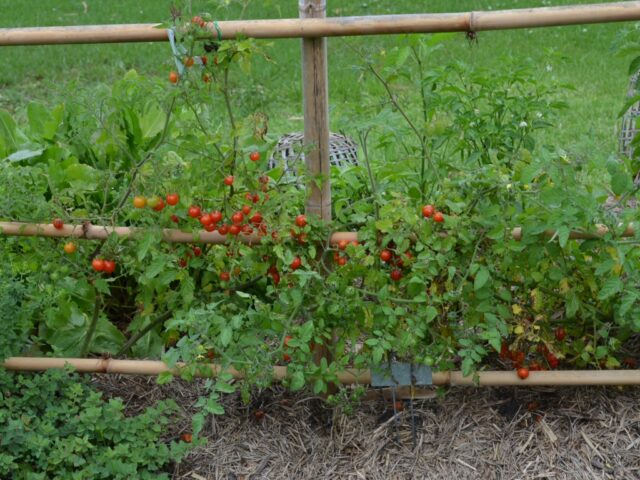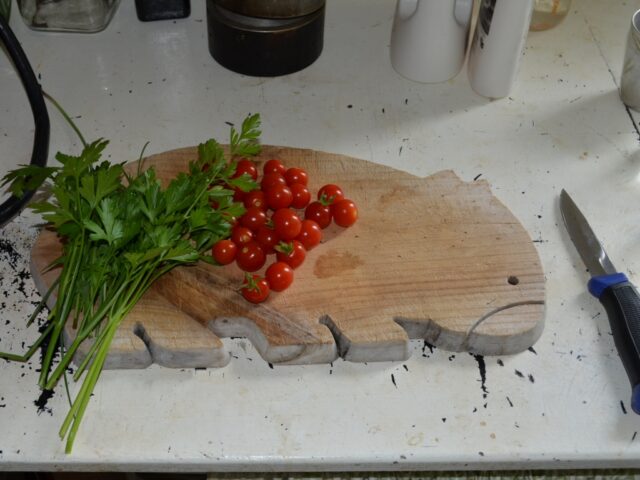How do I grow cherry tomatoes?
Spring is a great time to think about planting tomatoes. Many of us have memories of abundant tomato bushes sprawling around wooden stakes in our grandparent’s garden. The wonderful smell as the leaves of a tomato plant are brushed against evokes such images, as well as the amazing taste and texture of tucking into a fully vine-ripened tomato. It is rare to find this sight now in suburban backyards as most of us do not have the time or space to have a traditional vegetable plot with its neatly regimented raised beds. There is also the issue of pests and diseases that can reduce the best-laid tomato plant to ruin.
Do not despair if you want to bring a little touch of tomato magic into your garden, as there is a simple and easy answer - tiny tomatoes. As well as being more compact plants that can be more easily grown in pots, varieties with smaller fruit are far less prone to the pest and disease problems that make it a chore to grow the large fruited types. Large fruiting tomatoes can be susceptible to fruit fly attack, but they generally leave cherry tomatoes alone. And the problem of blossom end rot, which results in a brown hard patch on the bottom of the fruit, is much less seen in the smaller fruiting plants. Blossom end rot is caused by a disruption to the water supply to the fruit, the smaller size of cherry tomatoes means there is much less chance of drying out affecting the fruit.
The simplest option for getting started is to purchase a seedling plant either as part of a group in a punnet or as a somewhat larger plant in an individual container. Various varieties of tiny tomatoes are available in Australian nurseries, with some to watch out for being ‘Cherry Ripe’, ‘Sweetie’, ‘Tiny Tim’ and ‘Small Fry’. There are also interesting colour varieties in cherry tomatoes, with yellow, pink or black fruit, which look sensational in salads. All bear abundant fruit under the right conditions, and one plant will yield enough to keep a couple supplied with fruit throughout late spring, summer and autumn. Several plants will keep a family happy, and kids love finding the ripe fruit to snack on in the garden.
A handy tip to enhance your production is to prune the lateral shoots (the ones that arise from the main stem where a leaf joins it) from the plant and stick those into a separate pot as a cutting. Simply put the cutting(s) into a sheltered position where the pot will receive filtered light and usually it will strike roots within a couple of weeks giving you a new plant that will extend your tomato harvest even further.
A fun activity for kids is to raise a tomato plant from seed and then follow its progress through to munching on the finished product. It will normally require an adult to keep an eye on the plant as young gardeners may forget the water occasionally. Seed packets can be purchased or even better, harvest your own seed from some tiny tomatoes by squeezing them out onto some tissue paper. Spread them out evenly so there is a centimetre between seeds and then fold the tissue over to cover the seed. Then simply lay the tissue over some potting mix and just cover it with more potting mix and water it gently. After a couple of weeks seedlings should emerge which can be transplanted into individual pots when they are large enough to handle. Or simply squirt the contents of a cherry tomato straight into your garden bed, and lightly cover with soil- couldn’t be easier! Seed that comes up in the garden seem to grow more strongly than transplanted plants, in my experience. The beauty of cherry tomatoes is that fallen fruit will often germinate in the next season, growing on well without any work needed by the gardener.
Tomatoes are very rapid growers and as such require plenty of feeding as well as a reasonably well-drained soil. If you are growing them in the ground dig in a 5-10cm layer of well-rotted animal manure or compost. Otherwise pot culture is a perfect option and for best results choose a potting mix that conforms to the premium Australian standard, as this will have the extra fertiliser that tomatoes require to thrive. For best results it is desirable to liquid fertilise your plant every couple of weeks with a product such as Powerfeed ® or Aquasol ®. Another excellent way to give your plants a regular and gentle feed is by saving the water that is left over after boiling vegetables in the kitchen. The slightly green tinge it carries indicates a lovely mild dose of nutrients that have leached out during the boiling process (this water can be used on any plants in your garden that need a pep up in fact). That having been said, I have had self sown tiny tomatoes that I have completely neglected, with no food or watering, that have born quite tasty tomatoes. They may not produce large crops, but they can certainly produce useful amounts of food for no effort!
Tomatoes grow through the warmer months of the year and will not withstand frost so make sure you allow for this in colder climates when deciding when to plant. Starting plants off in a pot grown against a sunny wall will not only minimise any chance of frost, but the radiant heat at night-time will give your new planting an extra kick along. Once all danger of frost has passed it can be either transplanted into a larger container again or into a final position in the garden. Do not be afraid of pruning your tomato plant if it starts to become too rampant as cutting the plant back will cause it to branch out and produce more branches.
Did you know you can reproduce tomatoes by cuttings? They will root reasonably easily if placed into a pot of soil or into the garden, and kept moist but not wet while they form roots. This is a useful tip if you have an especially good plant that you would like to reproduce. You can keep propagating over winter for next year’s planting if you are especially keen.
A final tip is to let the tomatoes ripen fully on the vine to develop their best flavour and pick them just before you are ready to eat them. If for some reason you need to pick them before ripening on the vine, say, if you need to pull the plant out to use the space for something else, you can ripen them on a sunny windowsill. Hanging the vine upside down will also let your tiny toms ripen.
Cherry tomatoes are delicious just as they are, giving little pops of flavour. They are also good for cooking and can be added to sauces and stews. They are a great size to add to salads too. Remember that the greatest advantage of tiny tomatoes is that they do not generally require any pesticides and so you can enjoy them even more knowing that they are completely poison free.


